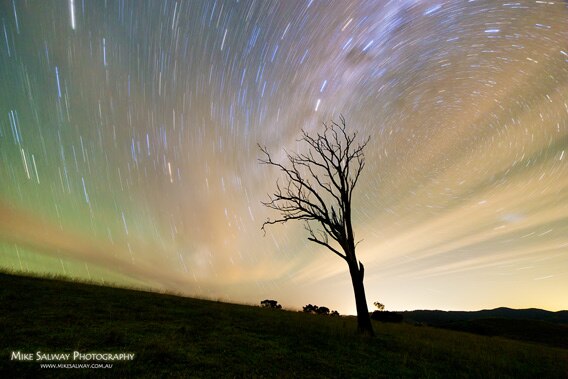Create a free profile to get unlimited access to exclusive videos, sweepstakes, and more!
A Hundred Billion Star Trails Over Australia

Astrophotographer Mike Salway has a good eye for the sky. A while back, I featured his amazing picture of a lighthouse set against the Milky Way, and now heâs done it again. He attended a star party in New South Wales, Australia, and took several simply stunning pictures of the night sky.
This first one is a 20-minute time exposure, allowing the stars to move across the sky during the shot:
He used a wide-angle 14 mm lens, which is why the sky is a bit distorted. But the colors! Clouds moving across the field of view created the odd, orange streaks. And the blur moving diagonally across the frame is the Milky Way itself, the combined light of a hundred billion stars.
Even in this long exposure, some features are obvious, like the dark hole of the Coalsack (above the tree), a thick cloud of molecular gas and dust about 600 light-years away. The bright streaks to the upper left of the Coalsack are from Crux, the Southern Cross, and just above the tree are two bright streaks from Alpha and Beta Centauri. Alpha Cen is the closest star system to Earth, only 4.3 light-years away, and was recently found to have an Earth-sized planet orbiting one of the stars in this triple system.
To the right you see the stars make smaller and smaller arcs as you close in on the pole of the sky. But remember: This is Australia, so that's the southern pole, not the northern one! You won't find Polaris or the Big Dipper here.
Another jaw-dropper he took shows the Milky Way behind a copse of trees:
Thatâs beautiful. Incredibly, itâs a 30-second exposureâthe night sky there must be darkâand you can see amazing detail in the Milky Way. Dust cloud filigrees line the central bulge of our galaxy, clusters of stars are scattered about, and the bright pink cloud is the Lagoon Nebula, a site of active star formation 4,000 light-years away. The Lagoon is big and bright enough to see even in small telescopes, and Iâve observed it many times myself ⦠as have much larger telescopes: I have more images of it here, here, and (a little more whimsically) here.
Can you see the faint red and blue fuzziness just below and to the left of the Lagoon? Thatâs the Trifid Nebula, another favorite for small telescopes, and well worth a deeper look. Itâs gorgeous.
By the way, Salway made a version of this you can use as computer wallpaper, too. Youâre welcome.
Salway took these shots attending the IceInSpace Astrocamp star party, which was in mid-April 2013. If you live anywhere near Sydney and need time away from the city to get out under the stars, this looks like a pretty good way to go about it.


























